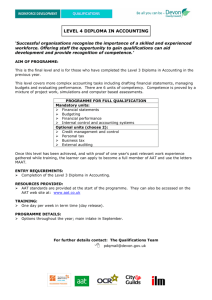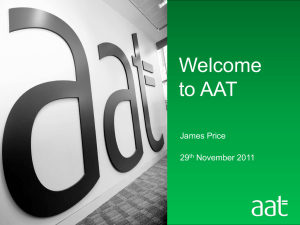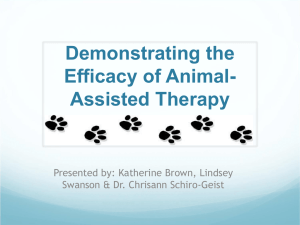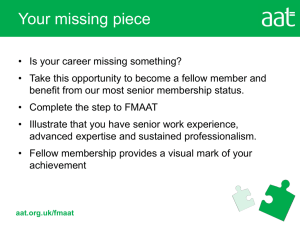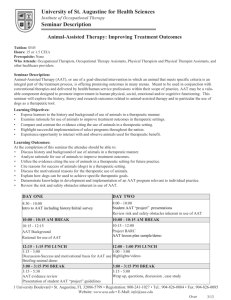Running head: ANIMAL-ASSISTED THERAPY i ANIMAL
advertisement
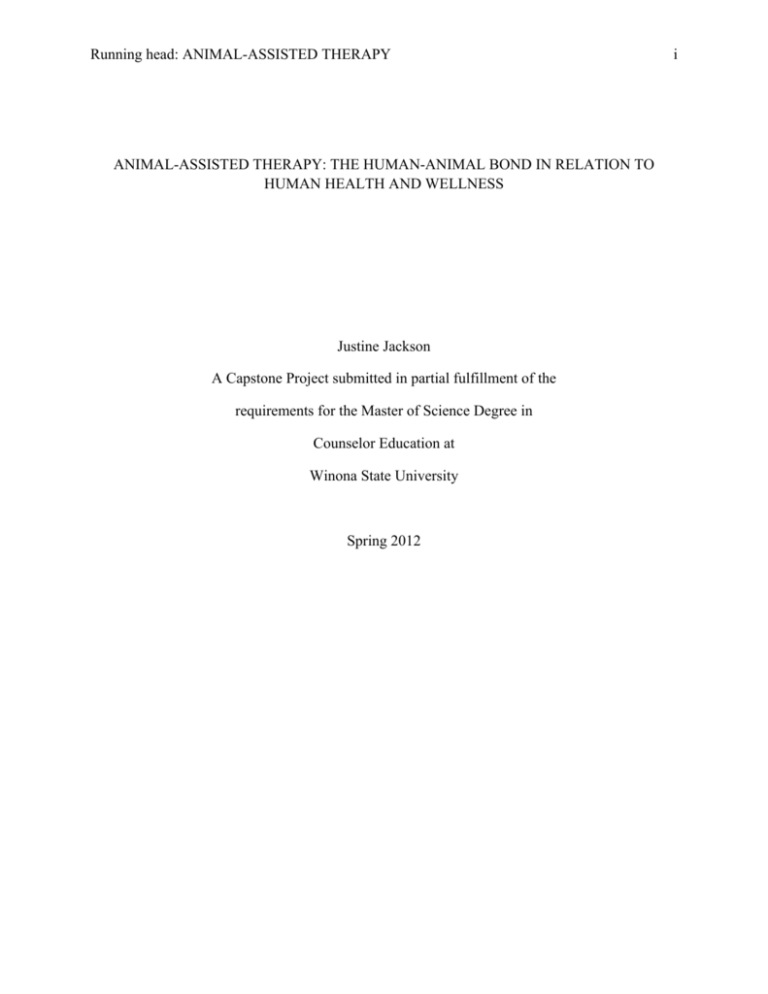
Running head: ANIMAL-ASSISTED THERAPY ANIMAL-ASSISTED THERAPY: THE HUMAN-ANIMAL BOND IN RELATION TO HUMAN HEALTH AND WELLNESS Justine Jackson A Capstone Project submitted in partial fulfillment of the requirements for the Master of Science Degree in Counselor Education at Winona State University Spring 2012 i ANIMAL-ASSISTED THERAPY ii Winona State University College of Education Counselor Education Department CERTIFICATE OF APPROVAL __________________________ CAPSTONE PROJECT ___________________ Animal-assisted therapy: The human-animal bond in relation to human health and wellness This is to certify that the Capstone Project of Justine Jackson Has been approved by the faculty advisor and the CE 695 – Capstone Project Course Instructor in partial fulfillment of the requirements for the Master of Science Degree in Counselor Education Capstone Project Supervisor: Name Approval Date: April 12, 2012 ANIMAL-ASSISTED THERAPY iii Abstract Animal-assisted therapy is an emerging field in the mental health profession. Previous research indicates that animal-assisted therapy provides physical, physiological, and psychological health benefits for clients as well as professionals. This project will discuss the history of animalassisted therapy, health benefits of animal companionship and animal-assisted therapy, and successful animal-assisted therapy programs in the United States. Ethical issues are addressed for professionals, clients, and animals. The purpose of this project is to educate the reader about the role animals play in humans’ lives and to propose an effective animal-assisted therapy program to incorporate into both individual and group therapy with specific populations. ANIMAL-ASSISTED THERAPY iv Contents Introduction ………………………………………………………………………………………1 Review of Literature ……………………………………………………………………………...2 Definitions………………………………………………………………………………...2 Types of Animal-Assisted Therapy……………………...............………………………..3 History of Animal-Assisted Therapy……………………………………………………...4 Animals’ Role in Human Lives…………………………………………………………...6 Benefits of Animal-Assisted Therapy……………………………………………………..7 Animal-Assisted Therapy and Special Populations……………………………………….9 Ethical Issues………………………………………………………………………….....12 Animal-Assisted Therapy Programs…………………….……………………...………..13 Program Proposal…...……………………………………………………………………15 Conclusion……………………………………………………………………………………….19 References ……………………………………………………………………………………….20 ANIMAL-ASSISTED THERAPY 1 Introduction The role animals play in the lives of humans goes far beyond survival needs. Relationships formed between human and animals, referred to as the human-animal bond, provide significant physical, psychological, and physiological benefits to human well-being. The human-animal bond may be formed in various ways including companion animals, also known as pets, and animal-assisted therapy. The purpose of this project is to discuss previous research that has been conducted on the benefits of the human-animal bond in relation to human wellbeing through companion animals with a focus on animal-assisted therapy. This project will address models of animal-assisted therapy and apply them to special populations including psychiatric patients, children, adolescents, adults, and the elderly. Finally, a discussion follows of successful AAT programs and the proposal of a new AAT program with specific incorporations from established AAT programs. ANIMAL-ASSISTED THERAPY 2 Review of the Literature Definitions The American Veterinary Medical Association’s Committee defines the human-animal bond as “a mutually beneficial dynamic relationship between people and other animals that is influenced by behaviors that are essential to the health and well-being of both.” Included in this definition is “emotional, psychological, and physical interactions of people, other animals, and the environment” (JAVMA, 1998, p.1675). Animal-assisted therapy (AAT) is formally defined by the Delta Society as “a goaldirected intervention in which an animal that meets specific criteria is an integral part of the treatment process” (Kruger, Trachtenberg, & Serpell, 2004, p. 4). AAT involves specifically trained animals and professionals working as co-therapists (Kruger et al., 2004). As a fundamental part of therapy, AAT is focused on the improvement of human physical, mental, emotional, and social functioning. Found in both individual and group counseling, AAT is a formal, documented, and evaluated treatment process. For the purpose of this project, AAT is not to be confused with service animals that are trained to assist people with disabilities (Fine, 2010). Assisting animals fall under the category of animal-assisted activities (AAA). AAT differs from AAA in that AAA do not involve specific treatment goals; the trained animal may be handled by volunteers, and the animal may be used for entertainment purposes. Previous research defines AAT and AAA as two independent categories. The most notable difference between the two is that AAT has scheduled sessions, each session involving specific treatment goals. AAA are more casual and spontaneous without a focus on treatment goals or progress (Fine, 2000; King, 2007; Urichuk & Anderson, 2003). ANIMAL-ASSISTED THERAPY 3 Types of Animal-Assisted Therapy Animals involved in AAT include, but are not limited to, dogs, cats, horses, donkeys, dolphins, birds, gerbils, hamsters, rabbits, and fish. Most commonly used in previous research is canine-assisted therapy which involves dogs and is the most common type of AAT. Canineassisted therapy is used with a wide variety of populations and is found in both group and individual therapy settings. The interaction between dogs and clients is an important aspect in canine-assisted therapy (Fine, 2000; Thompson, 2009). Feline-assisted therapy involves cats and is typically found in long term care facilities such as nursing homes and assisted-living homes. The presence of the cat is the most important aspect of feline-assisted therapy. Due to their independent nature, cats in feline-assisted therapy are often looked at as pets rather than therapy animals. The presence of an animal in a long term care facility gives a more comfortable and home-like feeling to the facility in which felineassisted therapy takes place (Fine, 2000, Velde, Cipriani, & Fisher, 2005). Equine-assisted therapy, also referred to as hippotherapy, involves horses and donkeys for both individuals and families. Equine-assisted therapy usually takes place at the horses’ establishment. The therapy portion includes patients caring for the horse by grooming and feeding and also includes riding (Fine, 2000). However, the majority of equine-assisted therapy takes place on the ground rather than horseback. An important element of equine-assisted therapy is that “therapists incorporate exercises with the client and horse to target behaviors and underlying emotions” (Jarrell, 2005, p. 41). Dolphin-assisted therapy (DAT) involves treatment taking place at the dolphins’ establishment where the client interacts or swims with dolphins in captivity. DAT formally ANIMAL-ASSISTED THERAPY began in the 1970s and is currently prevalent throughout Europe and is becoming popular in applicable regions in North America (Fine, 2000; Marino & Lilenfeld, 2007). DAT is becoming an increasingly popular treatment for “illness, disability, and psychopathology in children and adults” (Marino et al., 2007, p. 239; Whale and Dolphin Conservation Society, 2006). History of Animal-Assisted Therapy Though the first documented case of AAT was in 1792, many researchers believe incidents of AAT began at the beginning of mankind, between cavemen and wolves (Urichuk & Anderson, 2003). However, the first documented case was in England at York Retreat, an asylum, run by the Society of Friends. William Tuke used common farm animals in his York Retreat as part of the treatment process. Tuke stated that incorporating rabbits, chickens, and other common farm animals would “enhance the humanity of the emotionally ill” (Beck & Katcher, 1996, p. 132). As a means to control patients, Tuke found that farm animals lessened the use of drugs and restraints (Macauley, 2006; Urichuk et al., 2003). During the late 19th century, companion animals became increasingly common features of mental institutions in Europe (Fine, 2000). Allderidge (1991) noted that animals in these institutions provided a less prison like atmosphere. It was not until 1919 that the use of animals in a therapy setting was documented in the United States. Dogs were incorporated into the treatment of psychiatric patients at St. Elizabeth’s Hospital in Washington, D.C. The intended use for the dogs was to be companions for the patients (Allderidge, 1991; Urichuk, 2003). As animals involved in therapeutic settings became more prevalent, scientific medicine was introduced and pushed AAT aside until the late 1960’s when Boris Levinson’s work came about (Allderidge, 1991). Levinson, a child psychotherapist and pioneer of AAT, incorporated 4 ANIMAL-ASSISTED THERAPY 5 his own dog into therapy sessions with clients. Levinson’s paper entitled “The Dog as ‘CoTherapist’” (1962) gained recognition in the field of psychotherapy. Levinson advocated that with children in particular, companion animals assist ego development and overall healthy development as well. The relationship between a pet and child allows for children without emotional security and affection to find that with their pet (Levinson, 1969). Levinson also explored the role of animals in relation to patients with chronic mental illnesses who lived in supportive care. Levinson found that after bringing puppies into the supportive care for visitation, the patients reported less depressive symptoms than the group who did not interact with the puppies (Barker & Dawson, 1998; Levinson, 1969). The late 1970s and 1980s marked a turning point in the growth of AAT as a credited field (Fine, 2000). In the fields of nursing, medicine, and psychotherapy, AAT has been receiving growing attention as an applicable way of aiding patients (Martin & Farnum, 2002). Recent interest in AAT and medical value has been gained by a study conducted that found heart attack victims had prolonged life due to owning pets (Urichuk et al., 2003). As concluded in this study, the results found associations between animal companionship and decreased mortality one year after patients were released from a coronary care unit (Friedmann, Katcher, Lynch, & Thomas, 1980; Palley, Pearl O’Rourke, & Niemi, 2010). Interest in the human-animal bond has been paid more attention in the past few decades as a direct result of media’s coverage of the impact of animals on humans’ lives. Due to this attention, society’s curiosity regarding the unique relationships between humans and animals has increased (Fine, 2010). Animals’ Role in Human Lives ANIMAL-ASSISTED THERAPY 6 As mentioned previously, given the significant results of the life-prolonging effects of pet ownership among heart attack victims, there is considerable interest in the medical value of companion animals (Fine, 2000). As declared by previous research, pet owners receive physical health benefits from animal companionship. The physical health benefits begin, however, before interaction with an animal. The simplicity in looking at an aquarium with fish provides a decrease in anxiety and physiological arousal. The presence of an animal alone can reduce blood pressure (Pichot & Coulter, 2007). A study conducted by Friedmann, Katcher, Thomas, Lynch, and Messent (1983) measured the blood pressure of twenty-six children when a dog entered the room. The children did not have contact with the dog but were able to see it. Friedmann and colleagues found that the children’s blood pressure decreased when the dog entered the room. The study concluded that the very presence of a dog can decrease anxiety and lower blood pressure (Fine, 2000; Friedmann et al., 1983, Pichot et al., 2007). Along with physical health benefits are mental health benefits associated with animal companionship. Turner (2007) discusses that the human-animal bond is a well-documented relationship that has been around since the beginning of animal domestication. He points out that the strength of the bond allowed for animals to be less pet-like and more like members of the family (Tuner, 2007). In recent research progress has been made in identifying the psychological and physiological benefits of the human-animal bond. Sussman (1985) found that owning a pet can “decrease depression, anxiety, and sympathetic nervous system arousal in the owner” (p. 199). Companion animals, specifically dogs, expose their human companions to encounters with strangers, facilitate interaction among previously unacquainted persons, and help establish trust among the newly acquainted persons (Fine, 2000). Mader, Hart, and Bergin (1989) report that individuals who are either physically or mentally disabled notice substantial changes in their ANIMAL-ASSISTED THERAPY 7 social environment if accompanied by a dog. Instead of ignoring or avoiding them, other people are more likely to approach and socialize with them (Mader et al., 1989; Urichuk et al., 2003). Animal companions aid the developmental growth of children. Responsibility, competence, self-esteem, trust, learning about cause and effect, and feelings of empathy are characteristics that can be acquired through pet ownership. Social skills can be developed and practiced through the relationship with a pet (Pichot et al., 2007; Thompson, 2009). Animals increase motivation (Urichuk et al., 2003), provide social support, provide an outlet for nurturance, and positively influence self-esteem (Kruger et al., 2004). Fine (2000) reports that children with companion animals may develop a greater sense of empathy for others. Levine and Bohn (1986) conducted a study that found children with companion animals were more empathetic than children in pet-less homes. Covert, Whiren, Keith, and Nelson (1985) found that adolescents who owned pets had higher self-esteem scores than those who did not. The evidence is clear that companion animals provide significant benefits to human health overall. Benefits of Animal-Assisted Therapy Animals in a therapeutic setting offer similar benefits to those of animal companionship. Animals in a therapeutic setting may serve as a catalyst for discussion between therapist and client (Fine, 2000; Kruger et al., 2004) or in group therapy animals may serve as an ice-breaker or discussion topic amongst group members (Urichuk et al., 2003). Animals may make a therapeutic setting seem less threatening and more inviting (Kruger et al., 2004). Environments involving animals appear to be more friendly and comfortable to incoming clients and bring a sense of security and warmth to the therapy setting. Holding or touching an animal may act as a physical comfort, can be soothing, and can instill a sense of safety (Fine, 2000). Personal ANIMAL-ASSISTED THERAPY 8 development, such as speech and communication skills, can be enhanced by partnership with a therapy animal (Thompson, 2009; Urichuk et al., 2003). As mentioned previously, Friedmann and colleagues (1983) found that people exhibited lower blood pressure and experienced feelings of relaxation in the presence of a dog. Cole, Gawlinski, Steers, and Kotlerman (2007) conducted a study that measured blood pressure and anxiety levels in patients with advanced heart failure during a 12 minute period with a therapy dog. Cole and colleagues (2007) found that the presence of the therapy dog decreased patients’ anxiety levels, improved cardiopulmonary pressure, and decreased neurohormone levels. Previous research indicates that animal companionship may be associated with lowered heart rates and blood pressure, decreased stress levels (Anderson, Reid, & Jennings, 1992; Friedmann et al., 1980), reduced anxiety (Barker et al., 1998), alleviation of depression, and greater selfesteem (Walsh & Mertin, 1994). Though research is limited in relation to AAT, several studies suggest that incorporating an animal as part of the treatment process complements the therapeutic relationship between the mental health professional and client (Mallon, 1992; Thompson, 2009) Research indicates that AAT provides both physiological and psychological benefits to clients as well as mental health professionals. Fine (2000) and Thompson (2009) discuss the importance of animals complementing the therapeutic relationship and support animals being considered as an adjunct to the relationship between the mental health professional and client. Mental health professionals are less likely to experience burnout and fatigue in partnership with a therapy animal (Fine, 2000). Previous research on AAT indicates a common characteristic found across studies measuring the impact AAT has on human well-being. The characteristics are that client ANIMAL-ASSISTED THERAPY 9 attendance was enhanced and individual participation increased (Fine, 2000; Urichuk et al., 2003). Hart discusses that despite the recent interest and growing research on the benefits of animals role in human health, “a significant gap remains between that knowledge base and implementing it into treatment or support services for psychosocially vulnerable people” (Hart, 2010, p.59, as cited in Fine, 2010). Animal-Assisted Therapy and Special Populations Psychiatric Patients. A common theme presented in previous research in relation to AAT is that animals in a therapeutic environment produce calming effects in clients. Brickel (1982) discusses that therapy animals serve as a buffer and distract attention from anxietygenerating stimuli that clients may face. Barker and colleagues (1998) conducted a study that measured anxiety levels in adult psychiatric inpatients in relation to an AAT group session. These researchers measured two separate groups’ anxiety levels, one group interacting with a therapy dog and one solely recreational group. Patients in each group were asked to self report their anxiety levels before and after each group session by using the State-Trait Anxiety Inventory (Spielberger, Gorssuch, Lushene, Vagg, & Jacobs, 1983). The results of the study concluded that the level of anxiety in patients with psychotic disorders decreased twice as much in the AAT group session as compared with the recreation group. Barker and colleagues suggest that this result may be attributed to AAT offering a more comfortable and safe environment or perhaps that interacting with a therapy dog allows for diversions and fewer demands than traditional therapies (1998). Antonioli and Reveley (2005) conducted a study that measured levels of depression in relation to swimming with dolphins. The study consisted of an experimental group and a control group. Each group was asked to rate their level of depression before treatment and after ANIMAL-ASSISTED THERAPY 10 treatment using the Beck Depression Inventory (Beck & Steer, 1996) and the Hamilton Depression Rating Scale (Hamilton, 1980). Results of the study concluded that the experimental group experienced significant improvement in depression levels as compared to the control group. More recent research is attributed to Nepps, Stewart, and Bruckno (2011) who studied over a two year period the impacts that AAT had on the depression and anxiety levels of 218 mental health inpatients at Lancaster General Hospital. The AAT took place in a group therapy session that met weekly. Participants were asked to rate their anxiety and depression before and after each session using the Burns Anxiety Inventory (Beck & Steer, 1993) and Burns Depression Inventory (Beck et al., 1996). The results of the AAT group were compared to a stress management group that received no AAT. Findings included significantly decreased depression and anxiety in both the AAT group and stress management group. Nepps and colleagues, however, support that AAT can just as well impact physiological levels as a group without AAT present. Their findings suggest that neither group was significantly better than the other (Nepps et al., 2011). Children. Exposure to animals happens early in a child’s life. Animals may be present physically in the home or through pictures in book, television, wallpaper, blankets, or clothing. Urichuk and colleagues (2003) report that children who have regular contact with animals have been shown to have higher levels of self esteem which may be related to animals’ unconditional positive regard and nonjudgmental ear. Children often turn to their pets for social support by confiding when they have a problem and often play with their pet when they are stressed (Thompson, 2009). A study by Melson (1990) indicates that kindergarten children with a family pet have fewer behavioral problems when transitioning to public school (Urichuk et al., 2003). ANIMAL-ASSISTED THERAPY 11 Beginning a social relationship with an animal may be less intimidating than a social relationship with a human. The basic skills learned with an animal may be transferred to human relationships. (Martin et al., 2002). AAT is hypothesized to be an effective form of treatment for children with disorders characterized by a severe impairment of social functioning and interactions (American Psychiatric Association, 1994). Animals in a therapeutic setting may serve as a catalyst in progression and lessens resistance (Fine, 2000). Animals’ presence in therapy may assist the mental health professional in promoting unconditional acceptance, aid the child in learning to trust, and act as a utilization tool to help children see the value in life (Fine, 2000). The calming effect of the presence of an animal as stated previously is beneficial when working with children. Katcher and Wilkins (1997) note that children with attention deficit/hyperactive disorder are found to have more focus in a learning setting with an animal present. Adolescents. The value of AAT and children with regard to psychosocial benefits may also be pertinent to adolescents. Kruger and colleagues (2004) focused their research on AAT as an intervention in the treatment of adolescents with mental disorders. The authors found a reduction of anxiety in sessions, as well as improved attendance, interactions, and behavior. Rapport between the therapist and client was also established sooner in the relationship. The animals used as a part of the treatment process served as a catalyst for learning, a source of comfort, an outlet for nurturance, and a role model of positive interpersonal relationships (Kruger et al., 2004). Elderly. Barker and colleagues (1998) discuss the presence of a therapy dog in relation to elderly patients with dementia and Alzheimer’s disease. Barker and colleagues state that the ANIMAL-ASSISTED THERAPY 12 presence of a therapy dog resulted in lower heart rates and increased socialization (1998). The connection between animals and the elderly is that the “responsibility of owning a pet can promote good health by giving a sense of responsibility, purpose, and self-worth” (Pichot et al., 2007, p. 12). Pichot and colleagues note that these benefits are especially important when working with a population who may be in the position of “having to redefine their purpose in life” (2007, p. 12). Richeson (2003) conducted a study on elderly patients with dementia in a nursing home that measured the effect of AAT on agitated behaviors and social interactions. The study concluded that daily AAT decreases agitated behaviors and increases social interactions among the elderly with dementia (Richeson, 2003). Though there are significant benefits associated with AAT, special considerations are to be acknowledged when incorporating a therapy animal into the treatment process. Ethical Issues Ethical issues need to be taken into consideration when working in AAT for not only the mental health professional and client but for the animal as well. Just as mental health professionals are prone to burnout, animals as well may experience burnout and/or fatigue if overworked. The Delta Society has been instrumental in establishing standards to protect AAT animals and to professionalize the field (Fine, 2000). The selection process is one that should not be taken lightly when considering incorporating animals into therapy. A recurrent theme is pointed out in research: one size does not fit all (Fine, 2000; Thompson, 2009). Clients’ preferences for animals as well are to be taken into consideration when implementing AAT as a part of treatment. It is suggested that clients who have a fear of animals or allergies to animals may not be suitable for AAT. Also addressed is that clients with a history of animal abuse may as well not be suitable for AAT. Screening ANIMAL-ASSISTED THERAPY 13 clients should be incorporated before the utilization of AAT (Thompson, 2009; Urichuk et al., 2003). Zoonotic infections, or infections that can be passed from animals to humans, should be taken into consideration with AAT (Cole et al., 2007). Specifically, dolphin-assisted therapy (DAT) poses high risk for infections and parasitism in both dolphins and humans (Geraci & Ridgeway, 1991). Initial and regular health screenings by an animal specialist are essential for therapy animals. Adequate training and certification by an approved AAT organization is also essential when incorporating animals into the therapeutic process. Animal-Assisted Therapy Programs The Delta Society is the leading and one of the largest North American organizations in AAT. The Delta Society is a nonprofit organization that emphasis the importance of relationships between humans and animals. The Delta Society was founded in 1977 by Leo K. Bustad, a veterinarian, and Michael J. McCulloch, a psychiatrist. Bustad and McCulloch studied the benefits of pet owners’ health and happiness and advocated for more research in the field (Kruger et al., 2004; Palley et al., 2010). The Delta Society’s mission is to “help people improve their health, independence, and quality of life” through relationships with animals (Urichuk, 2003, p. 23). There are currently an estimated 2000 AAT programs in the United States, with psychotherapy and physical rehabilitation using dogs being the most common (retrieved from www.deltasociety.org). A second leading AAT organization, with a focus on canine-assisted activities, in the United States is Therapy Dogs International (TDI). Founded in 1976, TDI is the oldest AAT organization in the United States. The focus of TDI is to regulate, test, and register therapy dogs ANIMAL-ASSISTED THERAPY 14 and handlers for the purpose of AAA including visiting hospitals, nursing homes, prisons, schools, and other applicable areas for AAA. Specialized training and evaluation is required for registered therapy dogs of TDI (retrieved from www.tdi-dog.org). Dog Tags is a program that trains dogs, specifically Labradors and Golden Retrievers, to service people with mental and physical disabilities. Within Dog Tags is a program called Puppies Behind Bars that focuses solely on training dogs to service veterans wounded from war with a physical injury, traumatic brain injury, or Post Traumatic Stress Disorder. The title Puppies Behind Bars comes from the actuality of the dogs that are being trained living in prison with their trainers from the age of eight weeks to eighteen months. The trainers of these dogs are prison inmates across six different correctional facilities in New York. The inmates are specially trained within prison to raise a service dog. During their sixteen months in prison, the puppies live in the same cell as their primary raiser and attend weekly classes with a trained professional. During each month the puppies are exposed to life outside the prison by staying with foster homes. The puppies are constantly interacting with humans during the sixteen months. After their time is up in training they are tested to determine if they are adequate to be placed with the disabled. If the puppies pass they move on to more formal training outside the correctional facility. After the puppies complete their final professional training they are donated to veterans who apply for a service dog. If the puppies do not pass they are then donated to families with blind children. Not only does this program benefit the families who receive the dog but the prison inmates also gain positive social relationships through raising the puppies. This program has shown to be effective for the population that receives the dog as well as the trainers involved in the program (retrieved from www.puppiesbehindbars.com). ANIMAL-ASSISTED THERAPY 15 Program Proposal The purpose of this project is to propose an effective AAT program to incorporate into both individual and group therapy. The therapy animal of choice is canine-assisted therapy due to the supported previous research on dogs in relation to human well-being. Though specific dog breeds are preferred by some successful AAT programs, this program does not have breed requirements. However, it is required that the dogs involved in the program are not older than 8 to 10 weeks. Much like the Puppies Behind Bars program, the therapy dogs in this program will be raised with constant human interaction. The environment in which a dog is raised can greatly influence its adult behavior (Fine, 2010). By providing the dog with daily human interaction and attention, the dog will become accustomed to working with humans. The human interaction will include spending the majority of time with its trainer and also incorporate weekly stays at different households to increase interactions with different age groups and lifestyles. Specific training in this program will follow the guidelines for AAT established by Delta Society’s Pet Partner Program. The Delta Society’s Pet Partner Program focuses on training in a variety of areas, “including an awareness of health and skill aptitude of the animals, as well as strategies to incorporate the animals with the clients” (Fine, 2010, p. 185). The training program will begin at the age of eight weeks and continue until the age of two years. Included in the training program will be a focus on obedience, social interaction with all age groups, and temperament. At the end of the training program the dog will be tested on temperament and obedience. Dogs in the program that pass the testing requirements to be a therapy animal will then be available for work with a mental health professional. Dogs that do not pass will be donated to people in need of a service dog. As well as initial testing, mental health professionals and therapy dogs will be required to attend yearly continuing education classes. ANIMAL-ASSISTED THERAPY 16 This program will produce therapy dogs that are adequate for both individual and group counseling. Stipulations of incorporating a therapy dog into individual and group counseling from this program include the following: 1) Clients participating in AAT in either group or individual counseling must be screened for history of animal abuse, allergies, fear of dogs, or anything that pertains to working with a therapy dog. 2) Mental health professionals working with canine-assisted therapy must be specifically trained in the field of AAT. In order to be certified in AAT, mental health professionals will need to meet the requirements and pass the courses set by Delta Society’s Pet Partner Program which strongly advocates adequate training for both animals and mental health professionals (Fine, 2010). 3) Mental health professionals’ utilizing AAT will be responsible for ensuring the well-being of the therapy dog. Regular attention to the therapy dogs’ health is essential. To avoid burnout and being overworked, the mental health professional will monitor the therapy dog and the therapy dog will receive regular checkups by a veterinarian. Specific guidelines of this program include the following: 1) The mental health professional is always present when the therapy dog is present and the therapy dog is never alone with the client(s). 2) The therapy dog has access to an environment away from work activities, immediate removal of the therapy dog in stressful situations, and interactions with clients must be structured to ensure the therapy dog’s purpose to serve as a useful therapeutic agent (Serpell, Coppinger, Fine, & Peralta, 2010, as cited in Fine, 2010). The specific guidelines and requirements set in this program are to ensure the well-being of all parties involved in AAT. With the proper implementation of this program, it is expected that clients as well as mental health professionals experience the physical, physiological, and psychological benefits associated with the human-animal bond and AAT. ANIMAL-ASSISTED THERAPY 17 The purpose of implementing therapy dogs from this program is to positively enhance the lives of clients. Interactions with the therapy dog can be directive or non-directive. Examples of directive interactions include: touching or petting the dog, having the dog do tricks by either the therapist’s or client’s command, walking with the dog, and telling the dog about concerns rather than the therapist. Examples of non-directive interactions include: the mere presence of the dog to produce calming effects and using the dog as a catalyst for discussion about past relationships with companion animals. Importance is placed on the environment in which therapy dogs in this program are raised because of the variety of populations this AAT program will be effective with. Children are especially important to the AAT field. As discussed previously, children receive significant benefits to overall development when in relations with animals. Therefore, the implementation of this proposed AAT program would likely prove effective with children. Specific goals when implementing this AAT program into therapy with children include the following: 1) Establish trust and rapport between the mental health professional, client, and therapy dog. 2) Practice and improve social skills. 3) Decrease behavioral problems. 4) Improve self-esteem and confidence. 5) Provide a safe environment where the overall development of the child will be positively impacted. These are general goals to consider and as therapy progresses, treatment goals will become more specific and tailored to the client. Animals serve an important role in the lives of elderly. Numerous studies conducted have found positive associations between pet ownership and enhanced quality of life. Though previous research indicates that the majority of AAT programs with the elderly population take place in nursing homes and long-term care facilities, a goal of this AAT program is to produce therapy dogs that are successful in both inpatient and outpatient psychotherapy. Thus, this AAT ANIMAL-ASSISTED THERAPY 18 program will broaden the AAT field by utilizing AAT in the treatment of older adults in individual therapy. Clients with anxiety and depression concerns will fit the model of this program because of the quantitative research conducted on the effect of AAT in decreasing depression and anxiety among psychiatric patients. Goals to consider with clients who have depression and/or anxiety concerns include the following: 1) Establish rapport and trust in the therapeutic environment. 2) Provide a catalyst for discussion amongst therapist and client and/or between group members when utilized in group therapy. 3) Decrease symptoms and concerns of anxiety and/or depression in clients. Again, these goals provide a baseline for beginning AAT with clients and it is expected that goals will become accustomed to the client(s) involved. ANIMAL-ASSISTED THERAPY 19 Conclusion Research demonstrates that animals play a significant role in human health and wellbeing. Animal companionship and AAT form relationships between humans and animals that provide physical, physiological, and psychological benefits. The benefits are so significant to human health that recent medical attention has been paid to the field of AAT. Despite previous profound studies, there is still a need for both quantitative and qualitative research on the effects of AAT. AAT programs have the potential to be a successful part of treatment with a variety of populations if they are properly implemented. The overall goal of the proposed AAT program is to advance the understanding and increase the utilization of the health benefits animals provide in the lives of humans. Important considerations are necessary for the well-being of clients, therapy animals, and mental health professionals. Training and certification required for therapy animals and mental health professionals are the first steps to attain the positive impact of AAT for all parties involved. Past studies indicate that AAT proves effective with a variety of age groups, diagnoses, and settings. With a focus on effectiveness with different populations, the proposed AAT program will provide the opportunity to build upon both qualitative and quantitative research on the benefits of AAT in the mental health profession. ANIMAL-ASSISTED THERAPY 20 References Allderidge, P. H. (1991). A cat, surpassing in beauty, and other therapeutic animals. Psychiatric Bulletin, 15, 759-762. American Psychiatric Association. (2000). Diagnostic and Statistical Manual of Mental th Disorders (4 ed., text revised). Washington, DC. Anderson, W. P., Reid, C. M., & Jennings, G. L. (1992). Pet ownership and risk factors for cardiovascular disease. The Medical Journal of Australia, 157, 298-301. Antonioli, C. & Reveley, M. A. (2005). Randomized controlled trial of animal facilitated therapy with dolphins in the treatment of depression. British Medical Journal, 331, 1231–1234. Barker, S. B., & Dawson, K. S. (1998). The effects of animal-assisted therapy on anxiety ratings of hospitalized psychiatric patients. Psychiatric Services, 49(6), 797-802. Beck, A. T., & Steer, R. A. (1993). Beck Anxiety Inventory Manual. San Antonio, TX: Harcourt Brace and Company. Beck , A. T., Steer, R. A., & Brown, G. K. (1996). Manual for the Beck Depression Inventory-II. San Antonio, TX: Psychological Corporation. Berget, B., & Braastad, B. O. (2011). Animal-assisted therapy with farm animals for persons with psychiatric disorders. Department of Animal and Aquacultural Services, 47(4), 384390. doi: 10.4415/ANN_11_04_10 Brickel, C. M. (1982). Pet-facilitated psychotherapy: a theoretical explanation via attention shifts. Psychological Reports, 50, 71-74. ANIMAL-ASSISTED THERAPY Cole, K. M., Gawlinski, A., Steers, N., & Kotlerman, J. (2007). Animal-assisted therapy in patients hospitalized with heart failure. American Journal of Critical Care, 16(6), 575585. Covert, A. M., Whiren, A. P., Keith, J., & Nelson, C. (1985). Pets, early adolescence, and families. Marriage and Family Review, 8, 95-108. Dog Tags. (n.d.). Puppies behind bars. Retrieved from www.puppiesbehindbars.com. Eggiman, J. (2006). Cognitive-behavioral therapy: A case report--animal-assisted therapy. Topics in Advanced Practice Nursing eJournal, 6(3), 1-7. Fine, A. (ed.). (2000). Handbook on animal-assisted therapy: Theoretical foundations and guidelines for practice. San Diego, CA: Academic Press. Fine, A. (ed.). (2010). Handbook on animal-assisted therapy; Theoretical foundations and guidelines for practice (3rd ed.). San Diego, CA: Academic Press. Folse, E., Minder, C., Aycock, M., & Santana, R., (1994). Animal-assisted therapy and depression in college students. Anthrozoos, 8, 188-194. Friedmann, E., Katcher, A. H., Lynch, J. J., & Thomas, S. A. (1980). Animal companions and one-year survival of patients after discharge from a coronary care unit. Public Health Representative, 95, 307-312. Friedmann, E., Katcher, A. H., Thomas, S. A., Lynch, J. J., & Messant, P. R. (1983). Social interaction and blood pressure: Influence of animal companions. Journal of Nervous Mental Disorders, 171, 461-465. 21 ANIMAL-ASSISTED THERAPY 22 Geraci, J. R., & Ridgway, S. H. (1991). On disease and transmission between cetaceans and humans. Marine Mammal Science, 7, 191-194. Hamilton, M. (1980). Rating depressive patients. Journal of Clinical Psychiatry, 41, 21-24. Hart, L. A. (2010). Positive effects of animals for psychosocially vulnerable people: a turning point for delivery. In A. H. Fine (Ed.). Handbook on animal-assisted therapy (pp. 59-84). San Diego, CA: Academic Press. Jarrell, N. (2005). Equine therapy: Making the connection. Counselor, The Magazine for Addiction Professionals, 6(3), 41-46. Journal of American Veterinary Medical Association. (1998). Statement from the committee on the human-animal bond. Journal of the American Veterinary Medical Association, 212(11), 1675. Katcher, A., & Wilkins, G. G. (1997). Animal-assisted therapy in the treatment of disruptive behavior disorders in children. In A. Lundberg (Ed.), The Environment and Mental Health: A Guide for Clinicians, (pp. 193-204). Mahwah, NJ: Lawrence Erlbaum Associates. King, L. M. (2007). Animal-assisted therapy: A guide for professional counselors, school counselors, social workers, and educators. Bloomington, IN: Author House. Kruger, K. A., Tratchenber, S.W., & Serpell, J.A. (2004). Can animals help humans heal? Animal-assisted interventions in adolescent mental health. Center for the Interaction of Animals and Society, 1-37. ANIMAL-ASSISTED THERAPY 23 Levine, M. M. & Bohn, S. (1986). Development of social skills as a functioning being reared with pets. Proceedings of Delta Society International Conference. Living Together: People, Animals, and the Environment, Boston, MA. Levinson, B. M. (1962). The dog as “co-therapist.” Mental Hygiene, 46, 59-65. Levinson, B. M. (1969). Pet-oriented Child Psychotherapy. Springfield, IL: Charles C. Thomas. Macauley, B. L. (2006). Animal-assisted therapy for persons with aphasia: A pilot study. Journal of Rehabilitation Research and Development, 43(3), 357-366. Mader, B., Hart, L. A., & Bergin, B. (1989). Social acknowledgements for children with disabilities: Effects of service dogs. Child Development, 60, 1529-1534. Mallon, G. P. (1992). Utilization of animals as therapeutic adjuncts with children and youth: A review of the literature. Child and Youth Care Forum, 21(1), 53-67. Marino, L. & Lilenfled, S. O. (2007). Dolphin-assisted therapy: More flawed data and more flawed conclusions. Anthrozoos, 20(3), 239-249. doi: 10.2752/089279307X224782 Martin, F., & Farnum, J. (2002). Animal-assisted therapy for children with pervasive developmental disorders. Western Journal of Nursing Research, 24(6), 657-670. doi: 10.1177/019394502320555403 Nepps, P., Stewart, C., & Bruckno, S. (2011). Animal-assisted therapy: Effects on stress, mood, and pain. Journal of Lancaster General Hospital, 6(2), 56-59. Palley, L. S., O’Rourke, P. P., & Niemi, S. M. (2010). Mainstreaming animal-assisted therapy. Institute for Laboratory Animal Research Journal, 51(3), 199-207. ANIMAL-ASSISTED THERAPY 24 Pet Partners. (n.d.). Retrieved from www.deltasociety.org. Pichot, T., & Coulter, M. (2006). Animal-assisted brief therapy. New York, NY: Routledge. Richeson, N. (2003). Effects of animal-assisted therapy on agitated behaviors and social interactions of older adults with dementia. American Journal of Alzheimer’s Disease and Other Dementias, 18(6), 353-358. Serpell, J. A., Coppinger, R., Fine, A.H., & Peralta, J.M. (2010). Welfare considerations in therapy and assistance animals. In A. H. Fine (Ed.). Handbook on animal-assisted therapy (pp. 480-502). San Diego, CA: Academic Press. Spielberger, C.D., Gorssuch, R.L., Lushene, P.R., Vagg, P.R., & Jacobs, G.A (1983). Manual for the State-Trait Anxiety Inventory. Consulting Psychologists Press, Inc. Sussman, M. (1985). Pets and the family. New York: Haworth Press. Thompson, M. J. (2009). Animal-assisted play therapy: Canines as co-therapist. In G. R. Walz, J. C. Bleuer, & R. K. Yep (Eds.), Compelling counseling interventions: VISTAS 2009 (pp. 199-209). Alexandria, VA: American Counseling Association. Turner, W. G. (2007). The experiences of offenders in a prison canine program. Federal Probation, 71(1), 38-48. Urichuk, L. J., & Anderson, D. (2003). Improving mental health through animal-assisted therapy. Alberta, Canada: Chimo Project . ANIMAL-ASSISTED THERAPY 25 Velde, B., Cipriani, J., & Fisher, G. (2005). Resident and therapist views on animal assisted therapy: Implications for occupational therapy practice. Australian Occupational Therapy Journal, 52, 43-50. doi: 10.1111/j.1440-1630.2004.00442.x Walsh R. G. & Mertin, R. G. (1994). The training of pets as therapy in a women's prison: A pilot study. Anthrozoos, 7, 124-128. Whale and Dolphin Conservation Society. (2006). Dolphin therapy in the headlines. Retrieved from www.wdcs.org.au.
